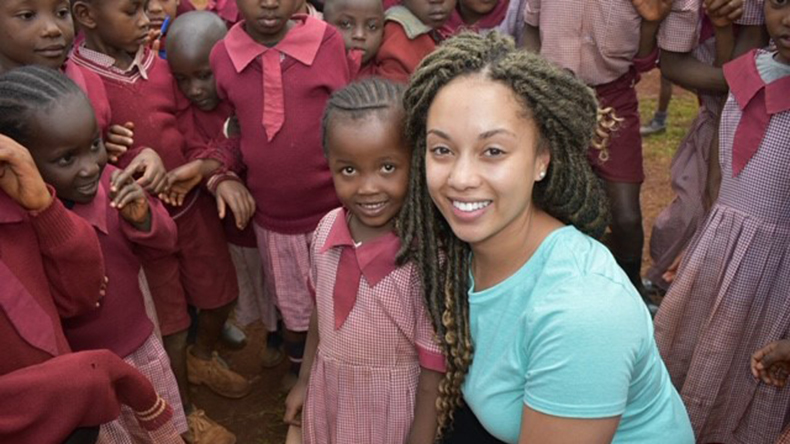“More than a credit on my transcript,” student shares the impact Service Learning and Cultural Immersion Program had on her

Clinical PsyD Student Sadé Callwood with students in Kenya.
What is it like to participate in a service learning and cultural immersion program as a student at William James College? In the reflection that follows, Sadé Callwood, a fourth year Clinical PsyD student, shares how her experience in Kenya has impacted her growth and development personally and as a clinician.
I really hoped the Kenya immersion would be a combination of personal and professional growth and development. While there was a recognition and respect for the intended academic agenda, I also saw the immersion as an opportunity for a spiritual mecca to occur, which I believed also deepened my growth as a developing clinician.
The immersion trip was much more than a credit on my transcript. Rather it was a journey back to the motherland, a welcoming home. I hoped that through my efforts with the students in each school I encountered, I would somehow, someway, make a difference in the life of at least one individual. I was unsure of how the students I interacted with would receive me. I had concerns about my inadequacy and whether or not what I had to offer would be enough. I truly wanted my impact to be much deeper than a surface level connection and instead I hoped to leave a lasting impression. While I walked away from each school feeling more and more accomplished, it was only during the last school visit that I recognized that both my personal and professional experiences and knowledge were exactly what I needed to be the best version of myself when working with the students.
One of my most cherished memories occurred during my last school visit with a large group of eighth grade students and two of my William James College peers. Initially, the classroom was quiet and seemed to be mostly unengaged with the strengths-based activity. I was almost positive that my last day teaching students about character strengths would be a massive flop, but I refused to let that be the case. With the support of my peers I drew on my past clinical experiences of working with clients who were slow to warm up and found ways to be more relatable to the students. I also drew on the various cultural nuances I had gathered from my other experiences in Kenya to make my examples and the larger activity more relevant to the students. By the end of the activity I was able to witness students be highly engaged with the activity as well as witness students discover, share and utilize their own strengths in front of the class that were deeply moving and emotional. These students shared stories that were reflective of trauma, healing and resilience.
The students who shared their character strength stories demonstrated what I was, at first, reluctant to believe – that the relational component of the work was the most critical and that the work we set out to do would be enough for those who needed and could accept what we had to offer at that moment. Most importantly, what allowed that experience for me to emerge was my recognition and acceptance that being exclusively present with the students and meeting them where they were at was enough. After being told by Claire and David* throughout the immersion that the feeling of never being able to give enough would happen quite often, I was able to see this for myself. Yet, I realized that allowing myself to be vulnerable with the students and sitting with their own journeys of recognizing and fostering strengths provided the opportunity for a mutual exchange of personal, spiritual growth to occur not only for the students, but also for myself.
This particular experience aligned with my vision for global work. I saw a vast clinical need within the communities I encountered. It was extremely important to me to not approach this kind of work from a savior standpoint, rather I had the intention of working with the communities on what they identified as their needs, while embracing that they in fact are the experts in their own experiences and I was simply a resource and gatekeeper to strategies and techniques that could help individuals increase their mental well-being.
*Dr. Claire Fialkov and Dr. David Haddad are the program’s faculty advisors. Read more about their work and the Kenya immersion program in the article, “Kenya Service Learning and Immersion Program Advances The Partnership for Safe Water in the Mara,” Other Community Health Initiatives” (August 2019). Learn more aboutall service learning and cultural immersion programs via the William James College Center for Multicultural and Global Mental Health (CMGMH) webpage.
- Tags:
- In the Community
Topics/Tags
Follow William James College
Media Contact
- Katie O'Hare
- Senior Director of Marketing
- katie_ohare@williamjames.edu
- 617-564-9389
